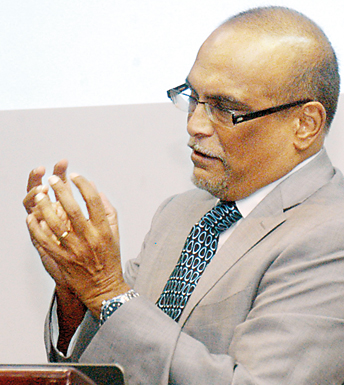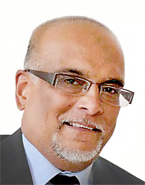Taking Sri Lanka to a nano future
Prof. Gehan Amaratunga is fond of quoting the Irish statesman and philosopher Edmund Burke in his classes at Cambridge University: “Nobody made a greater mistake than he who did nothing because he could do only a little.” In Prof. Amaratunga’s field of nanotechnology, however, little is littler than Burke could have ever conceived.

Prof. Amaratunga delivering the lecture on ‘Being Ingenious at the Nanoscale.’ Pic by Nilan Maligaspe
A nanometre is 1 billionth or 0.000000001 of a metre, and at that scale the world is a different place, so different that it has allowed us to dream up wondrous things: cloaks woven of nanostructures that deceive the eye and create the illusion of invisibility, minuscule submarines that could swim through your veins to find and eliminate a cancer, or minute farmers that could assemble meat for your dinner and wool for your clothing without the need to harm a single animal.
“You start to make things smaller and smaller and you come to this scale and then you start to find a strange confluence of engineering, chemistry and physics because as things get smaller and smaller they start to behave in a different manner,” says Prof. Amaratunga, adding, “They start to exhibit new physical and chemical properties because the surface of what you’re making is actually more important than the bulk of what’s inside it and that opens up a whole new area of what is called nanoscience and nanotechnology.”
Before the week is done, Prof. Amaratunga will have delivered the IESL Ray Wijewardene Memorial Lecture 2012 on his chosen topic: ‘Being Ingenious at the Nanoscale.’ “Physicists and chemists predict what is possible. Engineers prove them wrong and do things which are ingenious with them, hence the title of my lecture,” he explains. He takes a moment to savour the very word, ‘Engineer,’ pointing out that it is derived from the Latin word ingeniare. “It means creator of things ingenious,” says Prof. Amaratunga, adding wryly, “In France they still call us ingénieurs, whereas in English, in the anglicised form, that gets lost. People think it’s got something to do with engines.”
Prof. Amaratunga’s entry in Debrett’s People of Today, notes that his middle names are Anil and Joseph and that he is fond of Jazz, cricket, and vintage cars (back in the UK he has an Alfa Romeo Spider parked in his garage). It also outlines an exceedingly impressive career, punctuated with prizes and companies founded. Among the former are the RAE Research Award from the University of Cambridge, the IEE Prize from the Royal Academy of Engineering, the Overseas Secondment Award from Stanford University, with the most recent being the Silver Medal ‘for outstanding personal contributions to British Engineering’ courtesy the Royal Academy of Engineering in 2007. Not incidentally, he is an inventor on 22 patents.
He has held academic and research positions at Southampton University, the University of Liverpool and Stanford University in California and is currently the Group Leader of the Electronics, Power and Energy Conversion (EPEC) Research Group at Cambridge University (from where he received his PhD in 1983). He is also a Fellow of Churchill College, Cambridge and of the Institute of Electrical Engineers. He has published over 450 research articles in journals and conference proceedings.
All these honours make for an impressive resume, especially when Prof. Amaratunga admits that when he left Sri Lanka as an 18-year-old to study electronic engineering in the U.K, he was making it up as he went along. “I didn’t have a career path planned, I just seemed to be good at it. I stayed in the academic system as a prisoner of academic success,” he adds laughing. He is currently on leave from Cambridge and will be in Sri Lanka till September 2013, having put his training and knowledge at the service of SLINTEC (Sri Lanka Institute of Nanotechnology) as their Chief of Research and Technology. One of Tissa Vitharna’s advisors when the Minister of Scientific Affairs was first considering setting up a nanotechnology institute, Prof. Amaratunga says he wanted to see the project through. The initial concept was that the “institute would spearhead a new era of technology in Sri Lanka to enable us to think beyond the curve.”
However, this doesn’t quite mean marauding armies of nanomachines as yet. Instead the focus of the institute is far more pragmatic – “we have decided strategically that we should look at technology that can be applied to food, water, smart clothing for the apparel industry and nutraceuticals and minerals,” he explains.
SLINTEC recently formulated a fertilizer that was attached to nanoscale particles, allowing its slow release. Comparing them to drugs that humans ingest, Prof. Amaratunga explains that humans have to take a large dose to allow the body to ingest at least 10% – 20% of the drug – the rest is simply excreted, or in the case of plants, washed away into our rivers and oceans. A slow release fertilizer therefore makes more sense both economically and environmentally. Another project looks at water purification. Contaminants are a significant problem particularly where Sri Lankan households rely on groundwater. The presence of fluorides and heavy metals in the water as well as waterborne diseases can make it unsafe to drink.
“What may not be known by the lay public is that if you go to the west and you use a Brita water filter, it has a thing called activated carbon that is most likely sourced from Sri Lanka,” he says. Specially treated coconut shells act as filters, capturing both chemical compounds as well as biological agents. Why not find a way to produce them affordably for the local market? In yet another project, researchers are looking at the mineral ilmenite, so abundant on the beaches in the North Sri Lanka. Factories in other countries take this sand and produce valuable titanium for the aerospace industry, and Prof. Amaratunga would like to see some of that process completed here, adding value to what we export but simultaneously improving the manufacturing approach so that it is more sustainable and less energy intensive.
Thanks to a functioning Institute of Chemistry as well as the successes of the universities, Sri Lanka has a fine crop of chemists and Prof. Amaratunga believes we could leverage this to support the growth of nanotech here. “We are exploiting the benefits of that chemistry base to have nanotechnology that comes from chemistry synthesis rather than what we call top-down engineering,” he explains.
Back in Cambridge, his interests veer more toward energy and electronics. He has founded or co-founded four companies, including CamSemi and Enecsys. He says his particular interest has been in solid state electronics and how electronic devices can be shrunk ever further as in the microprocessors that power computers, mobile phones and the like. In fact, if you own a Nokia phone, there’s a good chance you’ll find a chip developed by CamSemi in it – the chip makes the mobile phone’s charger more efficient by controlling the conversion and eliminating the colossal wastage of power which was standard even five years ago.
His other interests include developing meta materials that can control the type of light that enters a solar cell, his work on super capacitors which are energy devices capable of storing and releasing energy and incredible rates as well as tackling the equipment related obstacles that get in the way of homeowners setting up small solar cell units – he’d like to see it become as affordable as buying a T.V.
As the lines continue to blur between science fiction and science fact, nanotechnology is among the most exciting fields to be working in, says Prof. Amaratunga. Like many engineers, he has “a missionary zeal to address problems of social significance through science and technology.” He also enjoys the freedom that working in both England and Sri Lanka has allowed him. With a foot in both countries, he freely admits that what he does is far from scientific research in its purest form, instead an engineer’s mandate is clear: it is to apply the best possible brains and human resources to the most urgent problems. It also allows for a neat division of his priorities: “I work on food and water in Sri Lanka and energy in England,” he says.
Follow @timesonlinelk
comments powered by Disqus



















